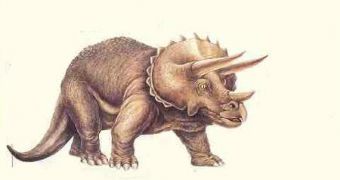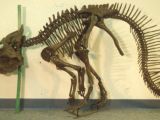The Triceratops is one of the best known species of dinosaurs: the huge, horned, rhinoceros like beast, up to 9 m (30 ft) long, 3 m (10 ft) tall and 12 tonnes heavy. But the huge beast and its relatives rooted from dwarf, dog-sized hornless Asian dinosaurs. A new species of dinosaurs discovered in a Montana is the long-sought link between the primitive Asian parrot-like beaked dinos and the huge North American horny dinosaurs.
The new species is hornless, and like the 'evolutionary cousins' of the horned dinos, the duck billed dinosaurs, they walked on two legs instead of four. The new species had extra teeth in its beak-like mouth, never encountered in the American evolved horned dinosaurs. "Dubbed Cerasinops, the fossilized female amounts to a missing link between two dinosaur groups that lived half a world apart some 80 million years ago," said dino's identifier Brenda Chinnery-Allgeier, a University of Texas paleontologist. "Cerasinops is exciting because of the traits that she has-some are known only in Asian groups, and other are known only from North American groups," she told to National Geographic.
"While the newfound species had the teeth of an Asian ceratopsian, it had chewing mechanisms that were unique to American dinos. The new dinosaur shows a direct link between Asian and North American horned dinosaurs that has been looked for for a long time," Chinnery-Allgeier said. "We knew that [the two groups] were related, but we didn't have any fossils that showed a mixture of characteristics like this and thus [demonstrated] the split between the Asian group and the North American group."
At a weight of 40 pounds (18 kilograms) and height of 3 feet (1 m), Cerasinops was no bigger than a large turkey. The fossil was first discovered by paleontologist Jack Horner near the town of Choteau in 1983. "It was preserved in reddish rock and was very difficult to see in the rock. After a team of experts prepared-or removed rock from-the fossil, the dino's distinct features began to take shape," said Horner, curator of paleontology at Montana State University's Museum of the Rockies.
But only after decades of new fossil discoveries in Asia, did the researchers gather enough knowledge to place this species in the dinosaur family tree. "I knew when it was prepared that it was probably a new species, but there weren't any researchers at that time that focused on protoceratopsians. So the specimen waited for 24 years before someone-Brenda-came along that could do the specimen justice", said Horner.

 14 DAY TRIAL //
14 DAY TRIAL // 
